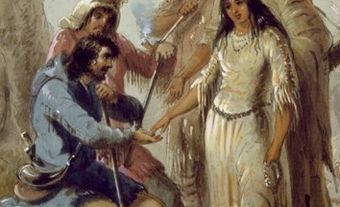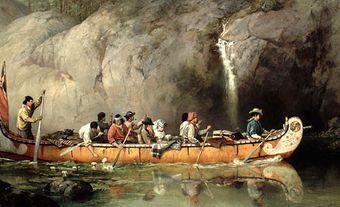Indigenous peoples in Canada were essential players in the fur trade of the early 17th to the mid-19th centuries. They provided animal furs, including highly sought-after beaver pelts, to European traders, who, in turn, gave Indigenous peoples manufactured items like pots, beads, textiles and weapons. While some past historians have framed the fur trade as a predominately unequal commercial exchange, it was conducted according to First Nations laws and principles, and worked to transform strangers into kin and sometimes even enemies into allies. When European traders arrived in North America, they entered an Indigenous world on Indigenous terms and travelled and traded there only with the co-operation and goodwill of First Nations. Indigenous peoples taught European newcomers how to behave in the fur trade, emphasizing the importance of gift-giving, reciprocity and family obligations. From an Indigenous perspective then, the fur trade was as much about family, co-operation and reciprocity as it was about commerce and exchange.

Beaver Trade
An Innu hunter declared to Father Paul Le Jeune in 1634: “The Beaver does everything perfectly well: it makes kettles, hatchets, swords, knives, bread; in short, it makes everything.” While the Innu hunter was playfully teasing the French missionary, his statement reflected the greater truth that Indigenous peoples recognized that the beaver was an extraordinary animal greedily sought after by French and English colonizers in North America.
French traders especially valued castor gras (“greasy beaver”), which was the worn-out beaver skins that had already been worn as coats, mantles, robes or blankets by Indigenous men, women and children for over a year. For their part, Indigenous people could not understand why Europeans came so far in search of their worn-out beaver robes. Castor gras skins were prized because constant friction, sweat and natural body oils loosened the coarse outer guard hairs, exposing the soft underfur beneath, which enabled furriers and hatters in Europe to ply their trade more easily.
In return for their old, worn-out beaver robes, Indigenous peoples received metalwares and other valuable merchandise that fulfilled a variety of utilitarian, ornamental and spiritual roles in their respective societies. The fur trade initially emerged as a mutually beneficial exchange process whereby First Nations exchanged their discarded beaver robes for life-changing trade goods, metal weapons and firearms.
European Trade Goods
Early on, Algonquian-speaking peoples (like the Anishinaabeg and Cree) described French and English trade goods — glass and porcelain beads, mirrors, cloth blankets, copper kettles, axes, knives, guns, shot and powder — as manitou or manidoo. This was an Algonquian concept that represented something that exceeded human abilities and that could control and manipulate the natural world in an extraordinary way. Siouan-speaking peoples (like the Dakota and Lakota) used the word wašicuŋ, instead of manidoo, to describe the sacred power they perceived in these novel technologies and trade goods. (See Religion and Spirituality of Indigenous Peoples in Canada and Indigenous Languages in Canada.)
Indigenous peoples with access to European weaponry and trade goods may have coveted these connections for themselves without necessarily wanting their neighbours — who were potential rivals or enemies — to gain the same advantage. Access to these powerful technologies and trade goods sometimes remade the geopolitical boundaries of Indigenous North America.
Military Advantages
Privileged access to the European traders enabled some Indigenous nations to leverage their relations with more distant peoples. For example, the Basquia and Pegogamaw Cree of the lower North and South branches of the Saskatchewan River asserted control of the western Canadian fur trade by assuming a dominant middleman’s role, exchanging European merchandise at inflated prices for the furs trapped by more distant Indigenous bands.
In other cases, exclusive access to European weapons allowed some First Nations to outright dominate their rivals militarily. Case in point, the Haudenosaunee’s superior access to iron weapons and firearms through their Dutch trade partners at Fort Orange (Albany, New York) may have been a critical factor in their conquest of the Wendat homeland (sometimes known as Huronia) in 1649–50. In the early 19th century, Plains Cree, Saulteaux (Plains Ojibwe), Nakoda (Assiniboine) and some Red River Métis formed the “Iron Alliance,” so named from their almost exclusive access to European metal technology, such as guns, kettles, hatchets and knives. They used these weapons to defeat their rivals and control access to the British-controlled Hudson’s Bay Company (HBC) and North West Company (NWC) posts in the western Great Lakes and the Hudson Bay watershed.

Reciprocity and Relatedness
When the English arrived on the frozen shores of Hudson Bay, and the French in the Great Lakes-St. Lawrence River Basin, they recognized a complex pre-existing system of Indigenous alliances and exchange networks. To trade in this overwhelmingly Indigenous world, English and French newcomers had to learn how to play by the rules, which included respecting trade protocols, ceremonial gift-giving, fostering reciprocal relationships, and acknowledging family obligations, responsibility and relatedness. The fur trade acted as a social glue that bound Indigenous peoples and newcomers together.
While many European fur traders, like the HBC, initially attempted to conduct the trade as a purely commercial exchange, this was simply not how trade functioned in pre-colonial North America. For Indigenous peoples, the fur trade was also a means of renewing friendships, creating alliances and preventing wars. The Ojibwe, for instance, only recognized two categories of people: relatives and foreigners. Like their Anishinaabe neighbours, the Očhéthi Šakówiŋ (Dakota and Lakota) framed society as an essential dichotomy: insiders versus outsiders. To trade with European newcomers, Anishinaabe or Dakota peoples would have to transform strangers into relatives. To achieve this, Indigenous peoples often imposed their own conceptions of kinship through adoption or marriage to create reciprocal social connections with European traders.
Commercial networks, political alliances and family ties intertwined and overlapped as the fur trade extended throughout the Great Lakes-St. Lawrence River basin, the Upper Mississippi Valley, the Lake Winnipeg basin, and the North and South branches of the Saskatchewan River. Until the late 19th century, the fur trade occurred in a largely Indigenous space, where kinship ties, not monarchs or empires, represented the main social structure and avenues of power. Prolonged cross-cultural and cross-community exchanges eventually gave rise to new peoples, particularly the Métis Nation of Western Canada.
Environmental Considerations
While the beaver has emerged as the quintessential symbol of the fur trade in Canada, other fur-bearing animals were also valued by European consumers, including the marten, muskrat, mink, fisher, otter, lynx and fox, all found throughout the rich fur-bearing regions of the Great Lakes-St. Lawrence River basin and the Hudson Bay watershed. The most productive environments for fur-bearing mammals (especially beaver) were the mixed forests, lakes and wetlands of Canada’s boreal woodlands. Within that vast biome, Indigenous hunters and trappers sought beaver lodges in the mazes of channels and marshlands that constituted river deltas.
The escalating involvement of Indigenous peoples in the fur trade did not come without its risks; often subsistence activities were neglected in favour of journeying to distant trading posts or engaging in commercial hunting, which threatened their well-being and that of their families. When some fur-bearing animals, like the beaver, were overhunted, it had dire ramifications for the local ecosystem. For example, beaver lodges and dams created places where fish spawned and where animals could drink all winter. Overhunting beaver was particularly perilous on the parklands and plains, where periods of drought were more common.
Limitations
The fur trade was not a universal phenomenon that defined all encounters between European colonizers and Indigenous nations. Not all Indigenous peoples resided in the boreal forest. Many First Nations, like equestrian plains nations, subsisted instead on the vast bison herds of the prairie parklands and northern plains. These peoples, who centred their societies and lifeways around a bison-based economy, had little interest in trapping beavers for European newcomers to their territories. For example, when HBC trader Anthony Henday visited a Niitsítapi (Blackfoot) encampment near present-day Red Deer, Alberta, an Elder rebuked Henday’s efforts to get the Niitsítapi to visit Hudson Bay by saying that they could not live without bison meat or leave their horses unattended. Even once fur trade companies built posts in Niitsítapi territory, the Niitsítapi refused to hunt beaver, which they understood as sacred animals who played an important role in retaining water during dry periods, and instead insisted on trading wolf pelts to the disappointed traders. For social, spiritual and ecological reasons, the Niitsítapi refused to hunt beavers for English colonizers or to give up an equestrian lifestyle and their bison-based economy.

 Share on Facebook
Share on Facebook Share on X
Share on X Share by Email
Share by Email Share on Google Classroom
Share on Google Classroom











